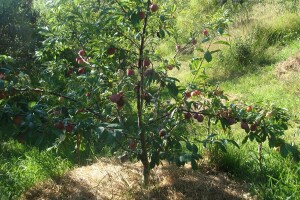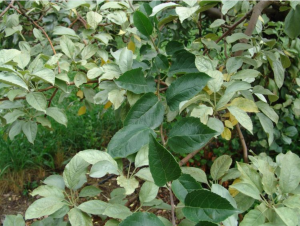A common disease of our fruit trees
Silverleaf is a fungal disease of trees and in particular some fruit trees such as pip and stone fruit, but also of other trees e.g., hawthorn. As with all disease it comes because our soils are often dead -lacking in minerals or the microbes we need for healthy plant growth and demineralised -lacking in the minerals required for healthy plant growth. As a result, our trees do not have high health and are not able to resist this fungal disease, because the microbes required to support high health trees are not present in high enough numbers to maintain tree health.
For us the focus must be on soil health and ecological resilience, and in this case an important focus is on feeding the fungi. Silverleaf is a disease that comes with out of balance fungi, not enough of the good ones or the ones we need, because the conditions are not right for them.
There are three things we can do:
1. Begin building the right conditions. We do that by planting loads of support species for our fruit trees that can be regularly coppiced and chipped to spread around as RWC (ramial wood chip) or chopped and dropped, see the booklet Designing and Managing Forest Gardens. This provides the food for the fungi and the fungi unlock the nutrients in this ramial wood and then it becomes available to the fruit trees… as well as strengthening the immune systems of the trees and protecting them from disease amongst other functions. This will build soil health and fungal health very fast. We have found though, that it takes several years to build the kind of resilience we require into our ecosystems (orchards and forest gardens) and if Silverleaf is an issue for you, as it has been for us, then inoculation is a great thing.
2. We can put the fungi we need to keep our trees safe into this environment… basically inoculate the ecosystem. Inoculating the system will help prevent our trees from becoming diseased by the Silverleaf fungi. But this will only work for the long term if these fungi (Tricho spp) have food to live on (i.e. ramial wood chip, or carbonaceous mulch)
3. We can also inoculate the trees themselves. Inoculation should eventually mean, so long as you are feeding your soil fungi, that after a few years you will have these Trichoderma spp in your own ecologies and you should no longer need to bring the inoculant in. We have found that it takes 3-4 years of inoculating diseased trees to obtain that level of natural inoculation.

Identification
Leaves have a silvery sheen, usually more noticeable in early spring, on the first flush of leaves and in autumn. This begins on damaged wood in the canopy, starting in one place and spreading down the tree. The fungus produces toxins that are taken up through the tree, causing the leaf tissue to separate, allowing air to enter, resulting in the silvery sheen.
As the disease progresses, leaf margins and the area around the midrib may split and turn brown. The wood of infected branches takes on a dark color, providing one of the ways to determine if it is silver leaf. Following this discoloration, the branches start to die back. In the summer after the branches have died, small bracket-shaped fruiting bodies form on the bark. These fruiting bodies release small round red balls that burst, releasing spores that can infect other open wounds.
The disease often spreads throughout the entire tree and can lead to its death if left untreated. It typically takes three or more years to go from an infection high up in a tree to growing down that branch and into the rest of the tree. Spores from the fruiting bodies infect trees through wounds in the wood; they do not infect the leaves. The spores are most active between March and November, making summer pruning, where possible, a great option.

Prevention
- Growing resistant cultivars and heritage trees that have co-evolved in living soil is crucial. These trees have undergone a lengthy process of co-evolution, resulting in better resilience.
- It is essential to cultivate high-health trees that have been grown in alive, mineralized soil, avoiding the dead soil commonly found in commercial nurseries.
- Ensuring good air movement and hygiene around plants is vital. This includes sterilizing secateurs between trees and promptly removing any diseased wood to prevent the spread of infections.
- Avoid over-fertilizing, especially with industrial or unbalanced fertilizers. Instead, consider feeding your trees through the soil fungi with RWC (ramial wood chip), which serves as a balanced fertilizer for trees.
- Maintaining good drainage is crucial for the overall health of the trees.
- Pruning in late spring or summer is recommended, as this is when infectious spores are produced. This helps minimize the risk of disease spread.
- When planting young trees, use 20 grams of Trichopel granules and water a couple of times over the following two months with Trichoflow for optimal growth and health.
Prevention & Cure using Inoculants
Trichopel is an insoluble granule designed for pre-planting use for all crops. It is formulated to provide a long-term food source for the Trichoderma. This ensures support to growing roots for up to 12 weeks.
Trichoflow is a wettable powder bio-fungicide, registered for a range of root diseases and designed for easy application through any irrigation method from watering cans, fertigation, and drippers to boom spray and flood jet. It is formulated with Seaweeds and Humates to improve the soil biology and support the colonisation of the Trichoderma around the roots.
Vinevax Tricho Dowels are impregnated with the living Trichoderma species and are used to inoculate and heal infected trees.
Vine Vax is a pruning wound dressing, to protect annual cuts from Silverleaf.
